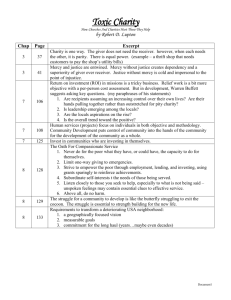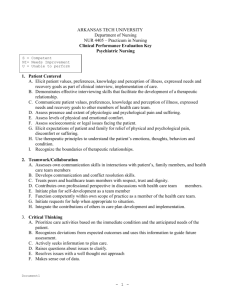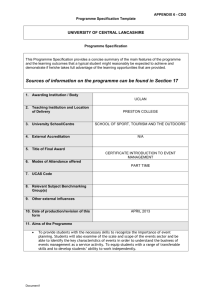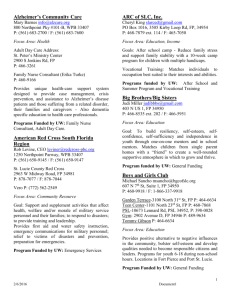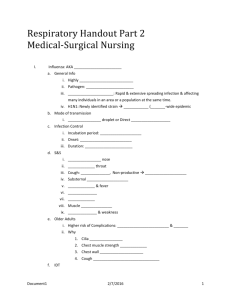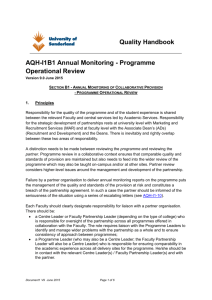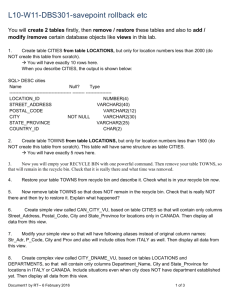Lecture 9 Handout: Reproductive System
advertisement
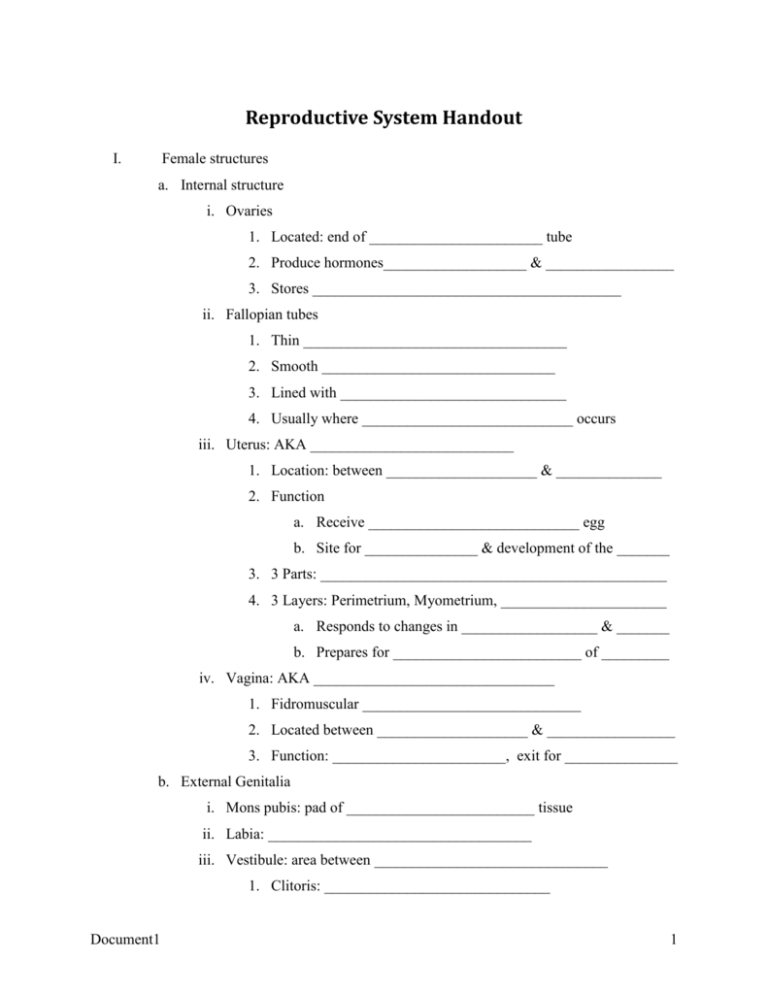
Reproductive System Handout I. Female structures a. Internal structure i. Ovaries 1. Located: end of _______________________ tube 2. Produce hormones___________________ & _________________ 3. Stores _________________________________________ ii. Fallopian tubes 1. Thin ___________________________________ 2. Smooth _______________________________ 3. Lined with ______________________________ 4. Usually where ____________________________ occurs iii. Uterus: AKA ___________________________ 1. Location: between ____________________ & ______________ 2. Function a. Receive ____________________________ egg b. Site for _______________ & development of the _______ 3. 3 Parts: ______________________________________________ 4. 3 Layers: Perimetrium, Myometrium, ______________________ a. Responds to changes in __________________ & _______ b. Prepares for _________________________ of _________ iv. Vagina: AKA ________________________________ 1. Fidromuscular _____________________________ 2. Located between ____________________ & _________________ 3. Function: _______________________, exit for _______________ b. External Genitalia i. Mons pubis: pad of _________________________ tissue ii. Labia: ___________________________________ iii. Vestibule: area between _______________________________ 1. Clitoris: ______________________________ Document1 1 2. ______________________ opening 3. ______________________ opening c. Breast / mammary gland i. Supported by ______________________________________________ ii. Richly supplied with ______________ ____________ _____________ iii. Primary purpose: ___________________________________________ iv. Structures 1. _____________________ 2. _____________________ 3. Mammary ____________________________ 4. Tail of _______________________________ II. Menstrual Cycle a. Endometrium responses to changes in __________________ b. Menstrual phase i. ______________________, slough & ____________________ c. Proliferative phase i. ______________________ & __________________________ d. Secretory phase i. ________ vascularity ii. Prepares to ______________________ fertilized _________ III. Assessment of Female Reproductive System a. Breast: i. S_________________________ ii. S_________________________ iii. C_________________________ iv. Skin _________________________ v. L__________________________ b. Pelvic i. Position: ____________________________ ii. Inspect iii. Palpate Document1 2 iv. Have the client “_________________ down” 1. _______________________ protrusions, incontinence c. Mammography i. ________________of the _____________________ ii. Purpose: Screen for _____________________________________ d. Abdominal Laparoscopy i. ______________ examination of the abdomen using _____________ tube ii. Abd is filled with ______________________________ iii. Nursing Care: Before 1. Informed _____________________ 2. Reinforce _______________________ 3. ____________________ questions 4. NOC before: __________________ & _________________ scrub 5. Empty _________________________ 6. Baseline _____________________ iv. Nursing Care After: 1. __________________ Vital signs a. Report temp > _____________________ 2. Apply perineal _______________ Change ____________ 3. Observe _________________: ____________________________, _________________________formation 4. May occur: ________________ pain, __________ through vagina & __________________ 5. Keep IV until _________________________ 6. Provide ________________________ instructions 7. When to notify MD: ________________intense ________ pain , _____________ , __________ leakage, _________________, Difficulty _________________ e. Colposcopy i. Examine: ________________ & _________________________ ii. Brightly lighted __________________________________ Document1 3 Small Group Questions 1. A patient is going to have a colposcopy. What teaching would you do before the procedure? 2. What would you note in a breast exam as being abnormal and worthy of further investigation? 3. Identify the anatomical structures that an ovum travels through and then exits the body (and their functions) 4. What is the endometrium and how is it different than other tissue of the body? 5. What would you teach your client following a laparoscopic procedure? IV. Endometriosis a. Endometrial tissue found _____________________ the uterus b. ____________________ locations: _____________ organs, _____________ c. Complications: __________________, __________________, scarring, __________________ d. S&S: Just before /during _________________ i. Dys _______________________ ii. Backache iii. _______________________ iv. Dys_____________________ v. Infertility e. Diagnostic procedure: ________________________________ f. Medication / treatment i. Pain: ______________________________________________ ii. Suppress ovarian function: ________________________________ V. Pelvic Inflammatory Disease a. ________________________ of the pelvic _______________________ b. Common Cause: ________________________ (Gonorrhea & Chlamydia) c. Major cause of female __________________________ d. Pathophysiology: Organism _________________ up ____________ ____ e. S&S Document1 4 i. High ____________________ ii. Vaginal ______________________ iii. ________________lower abd pain iv. _________________ v. _________________ vi. Dys ____________________ f. Tx/Rx ______________________________ & _________________________ i. Treat the ______________________________ too! Small Group Quesitons 1. Describe the pathophysiology of endometriosis? 2. What are the S&S of endometriosis? 3. What are the complications of endometriosis? 4. What is the pathophysiology of PID? 5. What is the primary cause of PID? 6. What is the usual treatment option for PID? VI. Breast Cancer a. General S&S i. ______________, __________________ ____________lump or mass ii. Change in ___________________/_______________of breast iii. ________________________ iv. Rash ___________________________ flaking v. Location: _______________________________________ quadrant VII. Mastectomy a. Nursing care before surgery i. Preoperative ____________________ ii. ____________________ teaching iii. Allow access to ____________________ persons iv. Offer ________________________ support b. Nursing care after surgery i. Routine ______________________ care Document1 5 ii. Reinforce teaching 1. Empty the ______________ and replace _____________daily 2. Return for drain ________________ in _________days per order 3. Take analgesics before ___________ becomes ________per order 4. Report excessive ______________________________ iii. ________________ & _______________ in axillary are common iv. Arm / shoulder _______________________ per MD order v. Drive: _________________________ vi. Return to work: ___________________________ vii. Don’t _____________________ with arm on operated side c. Grieving i. __________________ attentively ii. Spend __________________________ iii. Explain feelings ____________________ iv. Enlist ______________________ d. Risk for infection i. Assess _____________________, _____________________ ii. Enc ________________________________ iii. Teach incision ______________________________ iv. Report ______________________________________________________ v. Avoid ___________________________________________ vi. Skin ___________________________ e. Risk for injury i. Use ___________________________ side ii. ______________________________ arm on a pillow iii. Enc ________________ iv. Teach to ______________________________ f. Risk for disturbed body image i. Enc. _________________________________ ii. Explain _______________________________ iii. Include Document1 6 iv. Provide v. Enc. To _____________________ vi. Reassure: ____________________________________ VIII. Cervical Cancer a. Most r/t ________________________________________ (______) b. S&S i. Early; ______________________________________________ ii. Invasive CA 1. _____________________ 2. _________________ discharge 3. _______________ (back / thighs) 4. Weight _____________________ c. Diagnostic exam: Papanicolaou (__________) _____________________ i. During procedure 1. ______________ collected from the ______________ 2. Schedule test when not ___________________________ 3. Avoid__________, douching or vaginal meds ____ hrs before 4. _________________ before exam 5. ________________________ positing 6. ______________________ client ii. After procedure 1. Provide ____________________________ for cleaning 2. Provide _________________________ to protect garments 3. Allow _____________________ while client dresses 4. Prepare ________________________ & slides 5. Provide ________________________ iii. + Pap smear - _______________________, __________, ______ scan d. Cervical Biopsy i. Before 1. ___________________ 2. __________________ bladder Document1 7 ii. After 1. _________________ area 2. Perineal _____________________ 3. ________________ bleeding and vaginal ______________normal 4. No ____________________ x 1 wk 5. No___________ until ___________________cleared 6. Notify MD if __________________ bleeding, __________smelling discharge, _________________ or malaise e. Tx/Rx i. ________________________ ii. ________________________ iii. ________________________ f. Nursing Diagnosis: ____________________________________ IX. Hysterectomy a. Removal of the _________________________________ b. Approaches: ________________________ or ______________________ c. Advantages i. V _______________________________________________ ii. A ______________________________________________ d. Major risk factor: __________________________ and ________________ i. Enc _______________________ ii. Stop _______________________ iii. Promptly report _____________________________________________ e. Nursing care post-op i. Report: excessive _________________________ ii. Monitory for complications: 1. ___________________________ 2. ___________________________ 3. ___________________________ iii. Assess ________________________________ Document1 8 iv. Avoid: _____________________________________________________ ___________________________________________________________ v. Report 1. Temp _________________ 2. Vaginal _____________________________ 3. Urinary _____________________________ 4. Burning / __________________________ 5. Severe __________________ vi. Enc to ___________________________ vii. Provide info about __________________________ replacement viii. Reinforce importance of ______________________________________ Small Group Questions 1. What is the most common location for breast cancer to form? 2. What might a women feel on a BSE that would indicate a possibility of breast cancer? 3. What is the #1 cause of cervical cancer? 4. What screening is done for breast cancer and cervical cancer? 5. Differentiate between abdominal and vaginal hysterectomy. How might the nursing care differ? 6. Your client had a hysterectomy 24 hours ago. What would you teach her as part of her discharge teaching? 7. A client had a mastectomy 24 hours ago. You identify a nursing diagnosis of impaired body image. Identify 3 nursing interventions for this client. X. Male reproductive structures a. Testes i. Produce 1. _______________________________ 2. _______________________________ ii. Encased in: ___________________________ b. Epididymis: Houses ___________________ c. Vas deferens Document1 9 d. Seminal fluid: ________________, ______________ gland, ____________ gland i. Sperm + Seminal fluid = ____________________ e. Prostate Gland i. Location: Encircles the __________________ just below the __________ ii. Function: ________________ fluid, aids in ________________________ f. Penis i. Tip: _________________ covered by ________________________ ii. Removal of foreskin: _____________________________________ XI. Physcial Assessment of Male reproductive system a. Inspect _________________________ b. Palpate ______________________ area and ____________________ c. Penis:_____________________________________________________ d. Scrotum: ____________________ each testes e. Digital Rectal Exam (______________) i. Palpate ________________________________ f. Prostate-specific antigen (_____________) i. Levels rise 1. _________________prostate hypertrophy 2. ________________ of the prostate XII. Orchitis a. Inflammation of the ______________________________ b. Caused by _________________ or ______________________ i. _________________, pneumonia, TB c. S&S i. ______________ ii. ______________ iii. _______________ iv. Scrotal ______________________ d. Prognosis _________________ _____________________ e. Tx: i. Document1 ______________________ 10 ii. __________packs iii. Scrotal __________________________ iv. Bed ___________________ f. Rx: ________________________ , ________________________, XIII. Prostatitis a. Inflammation of the ________________________gland b. Caused by i. ___________________: Escherichia coli/ _____________ ii. __________-bacterial:Chlamydiae / Viruses c. S&S i. Pain, burning on ____________________: ______________Dyuria ii. ________________________ & urgency iii. _____________________& fever iv. Low_____________ , perineal or ________________pain v. Pain after _____________________________ vi. __________________________________urinary flow d. Diagnostic exam i. __________________, prostatic _______________________ ii. ________________ e. Tx / Rx i. Bacterial: _________________________________ ii. Non-bacterial: ________________________________ 1. Pain:_____________________________ 2. Voiding problems: ________________________ iii. _________ fluid intake iv. _____________ baths XIV. Phimosis a. _________________________ of the _______________________ b. Rick of: i. _______________________ infection ii. ________________________ of the glans Document1 11 c. Tx: ____________________________________________ XV. Cryptorchidism a. ___________________________________ testicle b. Increased risk of: __________________________ & ______________ c. Teach_____________________________________________________ XVI. Testicular Cancer a. Cause: ____________________________ b. Risk Factors i. Age: ___________________________ ii. _______________________________ iii. Family _________________ iv. Race/ ethnicity: ______________________ c. Pathophysiology: Cancer ______________________ normal cells affects _______ testicle Spreads________________ , but only ________________ d. Stages i. Stage 1: __________________________________ ii. Stage 2: Testicle + ______________________________ iii. Stage 3: ____________________________________ e. S&S i. _________________ __________________ nodule ii. Dull _________________ in ___________ or __________________ f. Tx i. Surgery: 1. ________________________________________ 2. Radical: __________________________________________ 3. Prosthesis ii. _______________________________ iii. _______________________________ XVII. Prostate Cancer Small Group Questions 1. Follow the path of sperm from formation to ejaculation. Document1 12 2. What is orchitis and what is its cause? 3. What are the symptoms of prostatitis? 4. How is prostatitis treated? 5. What are the S&S of testicular cancer? 6. What is the treatment for phimosis? 7. What is the complication associated with Cryptorchidism? XVIII. STDs / STIs ________________________________________________ a. Chlamydia i. General 1. Most _____________________________ 2. Leading cause of _____________________________ ii. Organism: ___________________________ iii. S&S: Female 1. _______________ maybe: _____________, ______________, vaginal __________________, pelvic _____________ iv. S&S Male 1. Maybe Asymptomatic: ____________, __________ or ___________ urethral discharge, Testicular ___________ v. Dx: __________________________________________ vi. Complications 1. Female: ___________, _______________spontaneous _______ 2. Neonates: ____________________ & pneumonia 3. Male ______________________ & Prostatitis b. Gonorrhea: AKA: _____________ or The ___________________ i. Mode of transmission: ___________ or ____________________ ii. S&S Female: Asymptomatic: maybe ____________ discharge, Abnormal _______________, Dysuria iii. S&S Male ___________, Frequency ______________ urethral discharge iv. Complications: Female 1. _____________________ Document1 13 2. _____________________ 3. Ectopic _____________________ 4. Abdominal _______________________ v. Compilations Male 1. ____________________ & sterility vi. Tx / Rx: ____________________________________________ c. Syphilis i. Primary: Painless ___________________ at site of exposure ii. Secondary: skin ______________, _________ mucus patches, ____________ malaise iii. Tertiary: _________________, inflammation of the __________, ______ damage iv. Tx/Rx: _______________________________________________ v. Complications 1. Disease ________________________________ 2. Tertiary: a. _____________ failure b. ______________________ c. Skin ___________________________ d. _________________ failure e. _________________ illness d. Genital Herpes i. Herpes ____________________________ type _____ ii. “Single or multiple small painful vesicles on an erythematous base on the genitals with associated pruritus, followed by painful ulcers” iii. Complications: Female 1. Herpes _____________________ 2. __________________ cancer iv. Complications: Neonates: 1. Affects: ____________, skin, mucous membranes and _________ v. Complications Male Document1 14 1. Herpes __________________ 2. ___________________algia 3. ________________________________ 4. Urethral __________________________ 5. ____________ forming in lymph nodes vi. Tx/Rx: No _________________________________________________ e. HIV/AIDS i. Mode of transmission 1. ____________________ contact 2. Direct _________________ of contaminated blood 3. ________________ to ___________________ ii. Causes destruction of __________________________________ iii. Kaposi’s sarcoma 1. ____________ on blood _________________ 2. Reddish-______________ lesions on the ___________and ______________________membrane 3. ____________________ painful iv. Wasting Syndrome 1. Unplanned __________________ loss ________________ 2. Chronic ____________________________ 3. ___________________________________ v. Tx/Rx 1. _______________________________ medications 2. H______________ A ________ Antiretroviral T___________ Small Group Questions 1. What is wasting syndrome in AIDS patients 2. What is the most common form of cancer associated with HIV? What are its symptoms? 3. What are the S&S of Chlamydia, Gonarrhea, Syphilis, and genital herpes? How are they each cured? 4. What can one do to prevent from getting an STI? 5. What is Herpes keratitis and which STI can cause it? Document1 15


